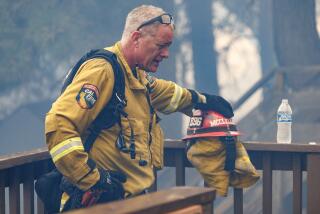Fire Officials Blame Staffing Deficit for Lack of Inspections
Scores of schools, offices, apartment houses and other major buildings in Los Angeles failed to receive annual fire inspections last year because of manpower shortages, city fire officials said Tuesday.
Despite substantial Fire Department personnel increases in recent years, the number of fire inspectors has failed to keep pace with the demands of new state fire laws and the city’s rapid growth, which has resulted in more than 450 major new buildings in less than seven years, said Battalion Chief Dean Cathey.
Fewer than half of the major commercial and industrial complexes in the rapidly growing San Fernando Valley were inspected last year as recommended by city policy, fire officials believe.
In other areas, inspectors completed a much larger share of their workload, but still struggled to meet deadlines. Inspectors visited more than 80% of the major buildings in the San Pedro-Los Angeles Harbor area, more than 90% of those in West Los Angeles and 100% of the high-rise buildings downtown, Cathey said.
Tower Was Inspected
The 62-story First Interstate Bank tower, which was heavily damaged May 4 in the city’s worst high-rise fire, had been inspected only a few months before the multimillion-dollar blaze, he said.
“There is no question we need additional staffing,” Cathey said. “We have been working over the last two or three years” to add more inspectors.
The department’s current staff of 123 inspectors, including eight who were added recently, represents an increase of 37 over the inspection staff of four years ago. But most of the new inspectors have been hired to deal with tougher state laws regulating hazardous chemicals and underground storage tanks, such as those used by gasoline stations, Cathey said. As a result, the Fire Department has fallen behind on the rest of its inspection work, he said.
However, Cathey and other officials denied that the shortfall has created a safety crisis for the department, saying that it is impossible to show evidence that yearly inspections always mean a reduction in the number of serious fires.
Scheduled Annually
Inspections of major buildings--including schools, hospitals, day-care centers and high-rise office buildings--are scheduled at least once a year, because fire officials consider that a reasonable timetable for doing the work, Cathey said. The schedules are not enforced by city, state or federal laws, he said.
In a story examining the inspection issue, the Los Angeles Herald-Examiner reported Tuesday that the problem is especially acute in the San Fernando Valley, where several hundred new buildings have been constructed in recent years.
According to the newspaper, about 90% of the offices, schools, churches and other public buildings in the valley were properly inspected seven years ago. But last year, the paper said, only 46.5% of the Valley’s large commercial buildings were inspected and only 37% of the public buildings, such as schools and churches, were inspected.
Fire officials, who were meeting Tuesday to consider the problem, were unable to verify the numbers, but believed that they are accurate, Cathey said. Officials are already conducting a study of inspectors’ caseloads to try to justify additional inspectors and possibly to reorganize the inspection department, he said.
Inspectors who handled 250 buildings a year in 1983 are now having to conduct 380 inspections a year, a 50% increase, Cathey said.
“That means he needs to be doing virtually two a day,” allowing for weekends and vacation time, the battalion chief said. “Some of those (buildings) are not getting inspected.”
Richard Dickinson, the Fire Department’s budget analyst in the city administrative office, said some previous requests for additional inspectors have been turned down because they had a relatively low priority.
The Fire Department, which has a yearly budget of $204 million, has placed greater priority on adding paramedics, improving its stress-management and training programs and replacing fire trucks, among other things, he said.
“It wasn’t presented to us as a big problem,” Dickinson said of the inspector shortage. “We would have looked at it a little closer if they had indicated this was a serious problem. . . . But this just wasn’t something that (fire officials) seemed to push for.”
More to Read
Sign up for Essential California
The most important California stories and recommendations in your inbox every morning.
You may occasionally receive promotional content from the Los Angeles Times.










